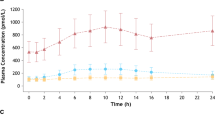Summary
It is well known that platelet aggregation shows a morning rise, which may contribute to the increase in the onset of ischaemic heart diseases during the morning period. The present study was undertaken to determine whether nocturnal dosage with S-1452, a thromboxane AZ receptor antagonist, would blunt the morning rise in platelet aggregability.
S-1452 50 mg or placebo were given orally to 8 healthy subjects at 10.00 h (day trial) or 22.00 h (night trial) according to a cross-over design. Plasma concentrations of S-1452 and its metabolites, bisnor-( + )-S-145 and tetranor-(+ )-S-145, and platelet aggregation were determined during the 12-hour period following the dose. Mean plasma concentrations of S-1452, bisnor-( + )-S-145 and tetranor-(+ )-S-145 during the absorption phase were lower after the nocturnal dose than after the morning dose. The maximum plasma concentration and area under the plasma concentration-time curve of the compounds were also lower and the time to the maximum concentration were delayed after the treatment at night. A morning rise in platelet aggregation was observed following placebo treatment. The inhibitory effect of S-1452 on platelet aggregation was observed at 3 hours and persisted for up to 9 h in both trials.
The results suggest that S-1452 is absorbed more slowly after the nocturnal dose than after the morning dose. However nocturnal treatment with 50 mg S-1452 may blunt the morning rise in platelet aggregability.
Similar content being viewed by others
References
Smolensky MH (1983) Aspects of human chronopathology. In: Reinberg A, Smolensky MH (eds) Biological rhythms and medicine. Springer Berlin Heidelberg New York, pp 131–209
Hirsh PD, Hillis LD, Campbell WB, Firth BG (1981) Release of prostaglandins and thromboxane into the coronary circulation in patients with ischemic heart disease. N Engl J Med 304:685–691
Conti CR, Mehta JL (1987) Acute myocardial ischemia: role of atherosclerosis, thrombosis, platelet activation, coronary vasospasm, and altered arachidonic acid metabolism. Circulation 75 [Suppl V]: V84–V95
Natale A, Rebuzzi AG, Ciabattoni G, Lanza GA, Bianchi C, Coppola E, Manzoli U (1990) Twenty-four hour TXB, production in unstable angina. In: Hayes DK, Pauly JE, Reiter RJ (eds) Chronobiology: its role in clinical medicine, general biology, and agriculture, Part A. Wiley-Liss, New York, pp 363–367
McCall NT, Tofler GH, Schafer AI, Williams GH, Muller JE (1991) The effect of enteric-coated aspirin on the morning increase in platelet activity. Am Heart J 121:1382–1388
Ridker PM, Manson JE, Buring JE, Muller JE, Hennekens CH (1990) Circadian variation of acute myocardial infarction and the effect of low-dose aspirin in a randomized trial of physicians. Circulation 82:897–902
Lemmer B (1986) The chronopharmacology of cardiovascular medications. In: Reinberg A, Smolensky M, Labrecque G (eds) Annual review of chronopharmacology vol. 2. Pergamon Press, Oxford, pp 199–228
Narisada M, Ohtani M, Watanabe F, Uchida K, Arita H, Doteuchi M, Ueda M, Hanasaki K, Kakushi H, Otani K, Hara S, Nakajima M (1989) Synthesis and in vitro effects on platelets and vascular smooth muscle of S-145, a novel thromboxane receptor antagonist. In: Samuelsson B, Wong PYK, Sun FF (eds) Advances in prostaglandin, thromboxane, and leukotriene research, vol. 19. Raven Press, New York, pp 659–662
Ohtani M, Matsuura T, Watanabe F, Narisada M (1991) Enantioselective synthesis of S-1452, an orally active potent thromboxane A2 receptor antagonist. J Org Chem 56:2122–2127
Fujimura A, Ohashi K, Ebihara A (1992) Daily variations in platelet aggregation and adhession in healthy subjects. Life Sci 50:1043–1047
Bruguerolle B (1989) Temporal aspects of drug absorption and drug distribution. In: Lemmer B (ed) Chronopharmacology. Dekker, New York, pp 3–13
Petralito A, Mangiafico RA, Gibiino S, Cuffari MA, Miano MF, Fiore CE (1982) Daily modifications of plasma fibrinogen, platelets aggregation, Howell's time, PTT, TT, and antithrombin III in normal subjects and in patients with vascular disease. Chronobiologia 9:195–201
Muller JE, Tofler GH, Willich SN, Stone PH (1987) Circadian variation of cardiovascular disease and sympathetic activity. J Cardiovasc Pharmacol 10 [Suppl 2]:S104-S109
Kishino J, Hanasaki K, Nagasaki T, Arita H (1991) Kinetic studies on stereospecific recognition by the thromboxane A2/prostaglandin H2 receptor of the antagonist, S-145. Br J Pharmacol 103:1883–1888
Author information
Authors and Affiliations
Rights and permissions
About this article
Cite this article
Fujimura, A., Kumagai, K., Ohashi, K. et al. Effect of treatment at night with S-1452, a thromboxane A2 receptor antagonist, on the morning rise in platelet aggregation. Eur J Clin Pharmacol 43, 501–505 (1992). https://doi.org/10.1007/BF02285091
Received:
Accepted:
Issue Date:
DOI: https://doi.org/10.1007/BF02285091




